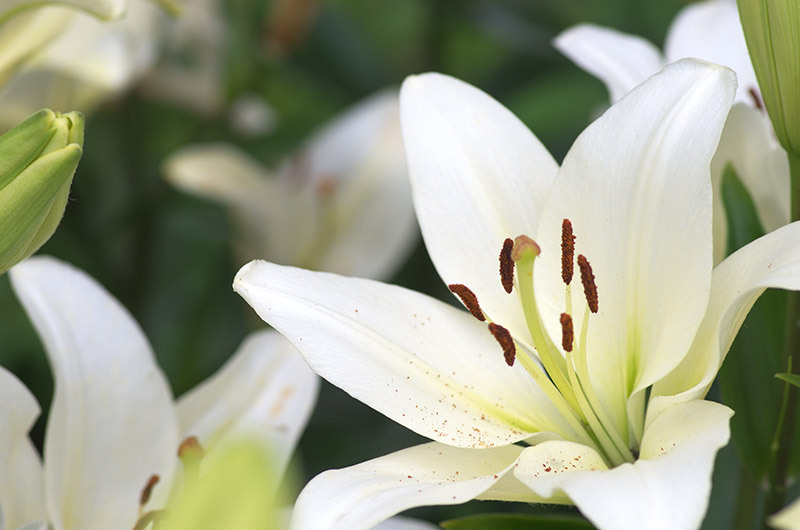Blooming Success: Effective Strategies for Hydrangea Maintenance
Posted on 13/08/2025
Blooming Success: Effective Strategies for Hydrangea Maintenance
Hydrangeas are among the most loved flowering shrubs, known for their large, showy blooms and versatility in gardens and landscapes. With the proper hydrangea maintenance techniques, you can ensure these stunning plants thrive, delivering abundant flowers and lush foliage every season. In this comprehensive guide, we'll delve into the key strategies for hydrangea care, covering everything from soil preparation and watering to pruning methods and pest prevention.
The Beauty and Versatility of Hydrangeas
Hydrangeas come in a variety of species and cultivars, offering gardeners a rich palette of colors, shapes, and sizes. Whether you're aiming to create a vibrant border or a striking centerpiece, successful hydrangea maintenance is crucial for achieving long-lasting beauty. Their ability to adapt to different environments adds to their popularity, but each type still has unique hydrangea care requirements.

Understanding Hydrangea Varieties
Before learning how to maintain hydrangeas, it's important to identify which type you have. The most common varieties include:
- Hydrangea macrophylla (Bigleaf Hydrangea): Known for their large mophead or lacecap flowers.
- Hydrangea paniculata (Panicle Hydrangea): Recognizable by their cone-shaped clusters and superb hardiness.
- Hydrangea quercifolia (Oakleaf Hydrangea): Distinctive lobed leaves and long, elegant panicles.
- Hydrangea arborescens (Smooth Hydrangea): Known for their round, snowball-like blooms.
- Hydrangea serrata: Smaller, more delicate flowers, closely related to macrophylla.
Understanding your hydrangea species will inform every aspect of your hydrangea maintenance routine, including pruning, planting location, and watering schedules.
Essential Strategies for Healthy Hydrangeas
1. Choosing the Right Location
Successful hydrangea maintenance begins with choosing the correct location. Most hydrangeas prefer partial shade - too much sun can cause wilting, while too much shade can limit blooming.
- Bigleaf and oakleaf hydrangeas thrive best in morning sun with afternoon shade.
- Panicle and smooth hydrangeas can tolerate more sunlight but require ample moisture in hot climates.
Tip: Hydrangeas dislike windy spots, which can dry them out and damage their large blooms.
2. Soil Preparation and Composition
The foundation of effective hydrangea plant care is healthy soil. Hydrangeas love rich, well-draining earth with high organic content. Here's how to prepare the perfect hydrangea bed:
- Amend the soil with compost, leaf mold, or well-rotted manure before planting.
- Ensure good drainage; hydrangeas dislike standing water, which can cause root rot.
- Test your soil's pH. Hydrangea macrophylla is famous for changing flower color based on pH: blue in acidic soil, pink in alkaline.
- Maintain a slightly acidic to neutral pH (5.5-7.0) for most varieties.
For ongoing maintenance of hydrangeas, add mulch each spring to retain moisture and regulate soil temperature.
Watering Your Hydrangeas for Peak Health
Consistent watering is vital for keeping hydrangeas vibrant. These plants have large leaves that transpire lots of water, and inadequate irrigation leads to wilting, fewer blooms, and stress.
Best Practices for Watering
- Water deeply at the base rather than overhead to minimize leaf diseases.
- Hydrangeas prefer moist, not soggy, soil. Aim for 1 inch of water per week, more during hot spells.
- Morning is the best time to water to allow foliage to dry by evening.
- Apply mulch 2-3 inches thick to keep roots cool and reduce evaporation.
Keep an eye on your plants, as hydrangeas will wilt dramatically when thirsty, but they usually bounce back quickly with adequate hydration.
Feeding Hydrangeas for Abundant Blooms
Fertilizing is another crucial element of hydrangea maintenance strategies. Too little nourishment can restrict flowering, while excessive feeding may encourage green growth at the expense of blooms.
- Apply a balanced slow-release fertilizer (10-10-10) in early spring as new growth starts.
- Avoid high-nitrogen fertilizers late in the season, as they may inhibit bud development for next year.
- For blue blooms on H. macrophylla, feed with aluminum sulfate; for pink, add lime to raise the pH.
Remember, healthy soil rich in organic matter often requires less supplemental feeding.
Mastering the Art of Pruning Hydrangeas
Pruning is often misunderstood, but with the right approach, you can maximize your hydrangea's health and flower output.
When and How to Prune
-
Bigleaf (H. macrophylla) and Oakleaf Hydrangeas:
- These bloom on old wood, so prune immediately after flowering--never in fall or spring, or you risk cutting off next year's buds.
-
Panicle and Smooth Hydrangeas:
- They bloom on new wood. Prune in late winter or very early spring before growth begins for robust flowering.
Always remove dead, damaged, or crossing branches first. Maintain an open shape for better air circulation, reducing disease risk.
Protecting Hydrangeas from Pests and Diseases
While hydrangeas are generally robust, certain pests and diseases can threaten their vitality. Vigilant hydrangea maintenance is your best defense.
Common Problems and Solutions
- Powdery mildew and leaf spots: Avoid overhead watering, prune for air flow, and remove infected foliage.
- Aphids and spider mites: Knock them off with water sprays or use insecticidal soap if infestations persist.
- Slugs and snails: Use organic pellets or traps to protect young plants.
- Root rot: Prevent by ensuring well-draining soil and avoiding overwatering.
Good garden hygiene, such as cleanup of fallen leaves and debris, significantly reduces disease pressure throughout the year.
Winter Protection and Seasonal Hydrangea Maintenance
In colder climates, some hydrangeas need extra care to survive harsh winters. Overwintering hydrangeas properly ensures strong regrowth and blooms the following spring.
- Mulch deeply around the base with straw, pine needles, or shredded leaves to insulate the roots.
- Wrap sensitive types (like bigleaf hydrangeas) in burlap or horticultural fleece.
- In spring, gently remove mulch and coverings once danger of frost has passed.
Remember, panicle and smooth hydrangeas are hardier and typically require less protection than macrophylla or oakleaf varieties.
Encouraging Bigger and Better Blooms
Want to see your hydrangeas laden with spectacular flowers? Employ these top hydrangea maintenance tips:
- Improve soil quality with annual additions of compost and organic matter.
- Water consistently through periods of drought, especially as buds form.
- Deadhead spent blooms where appropriate to encourage new growth (avoid deadheading varieties that set next year's buds in late summer).
- Monitor for pests and diseases regularly, treating problems early.
- Test soil pH and make appropriate adjustments for optimal bloom color and plant vigor.
Soil pH and Hydrangea Flower Color
One of hydrangeas' most intriguing characteristics is their ability to alter flower color based on soil pH--specifically, bigleaf hydrangeas. The color change is due to the plant's uptake of aluminum ions present in acidic soil.
- For blue blooms: Aim for a pH of 5.2-5.5. Acidify your soil with sulfur or peat moss, and add aluminum sulfate.
- For pink blooms: Keep soil pH above 6.0 by adding lime and avoid aluminum exposure.
- White hydrangeas generally don't change color based on soil chemistry.
Test soil annually, as rain and organic amendments naturally shift pH over time.
Hydrangea Maintenance: Long-Term Care Calendar
To achieve true blooming success with hydrangeas, follow a simple maintenance calendar throughout the seasons:
- Spring: Fertilize, prune (as needed by type), mulch, and monitor for new growth.
- Summer: Water consistently, deadhead spent blooms, and keep an eye out for pests.
- Fall: Light pruning if needed, remove diseased leaves, prep for winter, and apply compost.
- Winter: Protect roots and tender buds with mulch and covering; check for winter damage after storms.
Consistency is key--a thoughtful, year-round approach guarantees your hydrangeas will reward you with vivid, eye-catching displays.
The Benefits of Proper Hydrangea Care
Investing time in regular hydrangea maintenance brings a multitude of rewards for gardeners:
- Enhanced curb appeal and landscape value
- Healthier, more resilient plants resistant to pests and diseases
- More prolific and longer-lasting blooms
- Personal satisfaction from nurturing beautiful, thriving shrubs

Hydrangea Maintenance FAQs
Q: How often should I fertilize my hydrangeas?
A: Once in early spring and again in mid-summer, unless your soil is naturally rich. Always follow label instructions for your chosen fertilizer.
Q: Why aren't my hydrangeas blooming?
A: Possible causes include improper pruning (removing flower buds), too much shade, over-fertilizing, or winter damage to buds. Review your care routine and type of hydrangea.
Q: Can I grow hydrangeas in containers?
A: Absolutely! Choose compact varieties, use a large pot with good drainage, and monitor water closely--container hydrangeas dry out faster.
Conclusion: Cultivating Blooming Success with Hydrangeas
The journey to blooming success with effective hydrangea maintenance requires understanding your plants, catering to their needs, and adapting to your climate and soil conditions. By combining thoughtful site selection, balanced watering and feeding, timely pruning, and proactive pest management, gardeners can enjoy lush foliage and breathtaking blooms year after year.
Remember, no two gardens are alike; your own hydrangea care routine may take some experimentation to perfect. But with patience and these proven strategies, your hydrangeas are sure to flourish, adding beauty and charm to your outdoor living space for many seasons to come.
```Latest Posts
Why Red Roses Hold a Special Place on Valentine's Day
Blooming Success: Effective Strategies for Hydrangea Maintenance
The Heartfelt Impact of Flowers on Mood and Personal Well-Being





